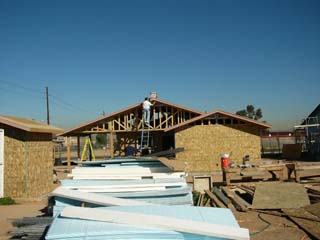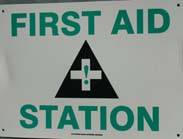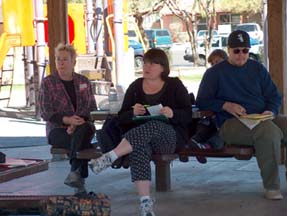| Home page
biography
Who is observing
who?
Ignorance
Subdivisions...a good thing?
Where would you send
your kids?
letter
|
Subdivisions…a good thing?
People
are often judged not only by how they look, dress, and act, but also
by where they live. In metropolitan Phoenix, this is especially
 true. When one hears that a person lives in South Phoenix,
they immediately assume that the South Phoenix resident must be
lower class and most likely an immigrant. Yet there are now organizations,
such as Habitat for Humanity, who are attempting to change that image.
Our class learned this first hand when we helped to construct
a home in South Phoenix. Habitat for Humanity builds new houses that
are beautiful and affordable. We are now seeing new Habitat subdivisions,
with new homes, clean playgrounds, and a friendly atmosphere.
true. When one hears that a person lives in South Phoenix,
they immediately assume that the South Phoenix resident must be
lower class and most likely an immigrant. Yet there are now organizations,
such as Habitat for Humanity, who are attempting to change that image.
Our class learned this first hand when we helped to construct
a home in South Phoenix. Habitat for Humanity builds new houses that
are beautiful and affordable. We are now seeing new Habitat subdivisions,
with new homes, clean playgrounds, and a friendly atmosphere.
Some
of the residents in South Phoenix, see the new residential subdivisions
in South Phoenix as a bad thing. This is due to the lack of knowledge
by some the residents in South Phoenix. Blake et. al. (1996) found
that their street names are Indian , Hispanic, or Black names. Since many people don’t know what these
names meant, they assumed that they were named for people of a lower
class. Each subdivision has a theme, and the street names are picked
to go along with that theme (1996). For example, if the theme is
happy, the streets might be named happy valley road, Smile Street,
or Glad Street. These names are picked out by city planners and the
community together. Residents of Phoenix, need to realize that although
it is true that in some subdivisions in South Phoenix, there is a
much higher percentage of minorities, the subdivisions are beautiful
and a nice place to live (1996).
, Hispanic, or Black names. Since many people don’t know what these
names meant, they assumed that they were named for people of a lower
class. Each subdivision has a theme, and the street names are picked
to go along with that theme (1996). For example, if the theme is
happy, the streets might be named happy valley road, Smile Street,
or Glad Street. These names are picked out by city planners and the
community together. Residents of Phoenix, need to realize that although
it is true that in some subdivisions in South Phoenix, there is a
much higher percentage of minorities, the subdivisions are beautiful
and a nice place to live (1996).
Phoenix
has been a rapidly growing geographic area since the 1950’s. There
are  approximately three million people living here. Phoenix is a place
where almost everyone owns a car, many people live alone, and almost
everyone shops in malls (Gammage, 1999). Yet, when people look at
how Phoenix is doing, it is doing fairly well (1999). Gammage (1999)
seems pleased that subdivisions that are popping up everywhere water
can be delivered to. Nonetheless, Gammage is keen to point out that
Phoenix has been able to keep its history. There are approximately
4,500 historic structures all through Phoenix. So, Gammage assumes
that although we live in a rapidly growing community, we are still
able to preserve our cities past.
approximately three million people living here. Phoenix is a place
where almost everyone owns a car, many people live alone, and almost
everyone shops in malls (Gammage, 1999). Yet, when people look at
how Phoenix is doing, it is doing fairly well (1999). Gammage (1999)
seems pleased that subdivisions that are popping up everywhere water
can be delivered to. Nonetheless, Gammage is keen to point out that
Phoenix has been able to keep its history. There are approximately
4,500 historic structures all through Phoenix. So, Gammage assumes
that although we live in a rapidly growing community, we are still
able to preserve our cities past.
In
conclusion, Phoenix is still a great place to live. It is important
to remember that even though there are subdivisions popping up constantly,
residents still take care of their community. Thanks to organizations,
such as Habitat for Humanity, we can be sure that the new subdivisions
will be a nice addition to our growing community. Hopefully some
day we will all be able to look back, and wonder why we weren’t happier
about the diversity in Phoenix. I believe that we are lucky to have
the opportunity to learn about other cultures, without having to go
to other countries.
as Habitat for Humanity, we can be sure that the new subdivisions
will be a nice addition to our growing community. Hopefully some
day we will all be able to look back, and wonder why we weren’t happier
about the diversity in Phoenix. I believe that we are lucky to have
the opportunity to learn about other cultures, without having to go
to other countries.

|

 true. When one hears that a person lives in South Phoenix,
they immediately assume that the South Phoenix resident must be
lower class and most likely an immigrant. Yet there are now organizations,
such as Habitat for Humanity, who are attempting to change that image.
Our class learned this first hand when we helped to construct
a home in South Phoenix. Habitat for Humanity builds new houses that
are beautiful and affordable. We are now seeing new Habitat subdivisions,
with new homes, clean playgrounds, and a friendly atmosphere.
true. When one hears that a person lives in South Phoenix,
they immediately assume that the South Phoenix resident must be
lower class and most likely an immigrant. Yet there are now organizations,
such as Habitat for Humanity, who are attempting to change that image.
Our class learned this first hand when we helped to construct
a home in South Phoenix. Habitat for Humanity builds new houses that
are beautiful and affordable. We are now seeing new Habitat subdivisions,
with new homes, clean playgrounds, and a friendly atmosphere.
 , Hispanic, or Black names. Since many people don’t know what these
names meant, they assumed that they were named for people of a lower
class. Each subdivision has a theme, and the street names are picked
to go along with that theme (1996). For example, if the theme is
happy, the streets might be named happy valley road, Smile Street,
or Glad Street. These names are picked out by city planners and the
community together. Residents of Phoenix, need to realize that although
it is true that in some subdivisions in South Phoenix, there is a
much higher percentage of minorities, the subdivisions are beautiful
and a nice place to live (1996).
, Hispanic, or Black names. Since many people don’t know what these
names meant, they assumed that they were named for people of a lower
class. Each subdivision has a theme, and the street names are picked
to go along with that theme (1996). For example, if the theme is
happy, the streets might be named happy valley road, Smile Street,
or Glad Street. These names are picked out by city planners and the
community together. Residents of Phoenix, need to realize that although
it is true that in some subdivisions in South Phoenix, there is a
much higher percentage of minorities, the subdivisions are beautiful
and a nice place to live (1996).  approximately three million people living here. Phoenix is a place
where almost everyone owns a car, many people live alone, and almost
everyone shops in malls (Gammage, 1999). Yet, when people look at
how Phoenix is doing, it is doing fairly well (1999). Gammage (1999)
seems pleased that subdivisions that are popping up everywhere water
can be delivered to. Nonetheless, Gammage is keen to point out that
Phoenix has been able to keep its history. There are approximately
4,500 historic structures all through Phoenix. So, Gammage assumes
that although we live in a rapidly growing community, we are still
able to preserve our cities past.
approximately three million people living here. Phoenix is a place
where almost everyone owns a car, many people live alone, and almost
everyone shops in malls (Gammage, 1999). Yet, when people look at
how Phoenix is doing, it is doing fairly well (1999). Gammage (1999)
seems pleased that subdivisions that are popping up everywhere water
can be delivered to. Nonetheless, Gammage is keen to point out that
Phoenix has been able to keep its history. There are approximately
4,500 historic structures all through Phoenix. So, Gammage assumes
that although we live in a rapidly growing community, we are still
able to preserve our cities past. as Habitat for Humanity, we can be sure that the new subdivisions
will be a nice addition to our growing community. Hopefully some
day we will all be able to look back, and wonder why we weren’t happier
about the diversity in Phoenix. I believe that we are lucky to have
the opportunity to learn about other cultures, without having to go
to other countries.
as Habitat for Humanity, we can be sure that the new subdivisions
will be a nice addition to our growing community. Hopefully some
day we will all be able to look back, and wonder why we weren’t happier
about the diversity in Phoenix. I believe that we are lucky to have
the opportunity to learn about other cultures, without having to go
to other countries. 